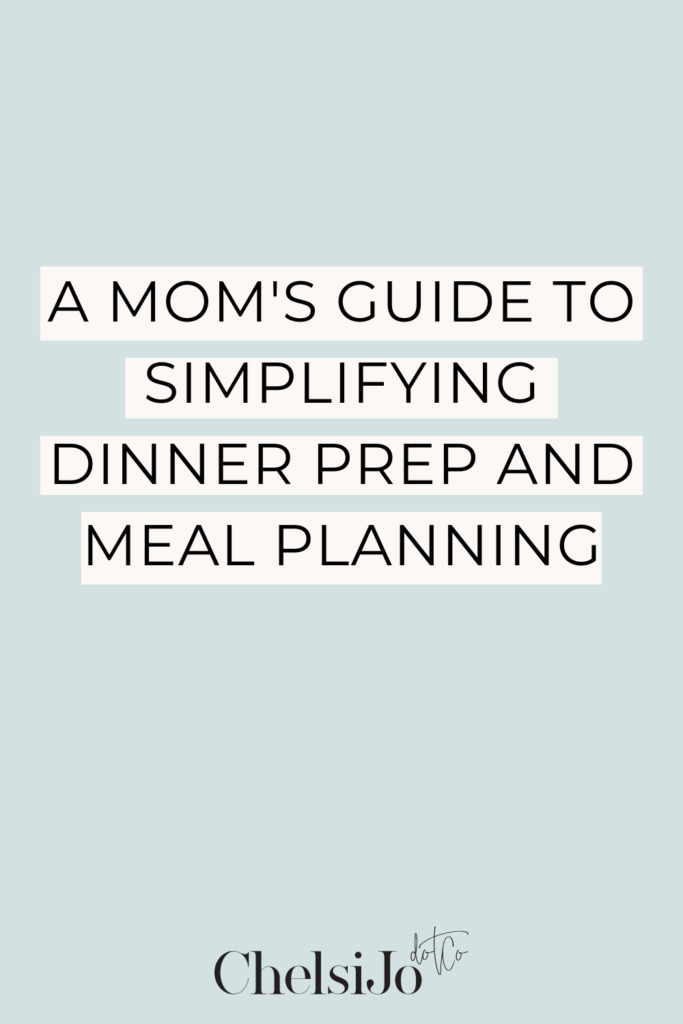Getting dinner on the table is one of the biggest repeating challenges that we face as work from home moms. Today, I am going to share ten tips that make cooking dinner at home easier while also saving you time and money.
Feeding your family is much more involved than just having food in the fridge. It is about nourishing your bodies and enjoying food in the process. If you find yourself going through the drive thru more often than you’d like or wasting the food you’ve bought, today’s post will be extremely helpful for you.
Listen below for the entire episode on The Systemize Your Life Podcast
Simple but Important
Food is an awesome opportunity for you to pour into your family that can impact so many different areas of your life. Today we will focus on the steps you can take to simplify the process of planning, buying, prepping, and cooking meals to create more time in your schedule to do the things that you love doing.
I very clearly remember how complicated I made this when my youngest daughter had just been born. Blaine and I had not been married very long, we had two little girls, and I was working really hard on my business. The amount of time I was spending on providing dinner for our family was unbelievable. When I did the homework that I am giving you at the end of this post, I was amazed at where my time and money was going.
How to Make Cooking Dinner at Home Easier
The homework at the end of this post is very impactful and I hope you do it. Whenever I give you homework like this or when you take it upon yourself to implement something you read about on our blog, if you get stuck, please pop over to our Facebook group. We are so happy to follow up with you and encourage you on your journey! Make sure you read to the end and make it matter by doing something with what I’ve given you.
The goal today is that you walk away knowing which of these 10 tips for making cooking at home easier you need to focus on. Obviously, when I give you a list of ten things, there are a lot of different options and angles for how to improve. You can put the puzzle together in many different ways. While these concepts apply to breakfasts and lunches as well, we will be mainly focusing on dinner in today’s post.
Grab your pen and notepad and let’s get started!
1. Have a Menu Board
A menu board is a board that you use to visualize your weekly meals and their associated shopping list by creating menu cards. I have an entire post dedicated to menu boards and menu cards here, as well as several podcast episodes you can locate in my Podcast Vault.
The Podcast Vault is searchable which makes it super easy to locate other resources for topics I’ve already covered. Use the search function on your computer (command + F or control + F, depending on the computer you’re using). Go check it out and search “menu” to find out more about menu boards.
Using a menu board has cut my meal planning time down to 5-10 minutes for the entire week. It is truly a game changer! The rest of the tips are not listed in order of importance, but this first tip really is #1.
2. Meal prep ahead of time
You should be prepping on the weekends or buying pre-prepped food! Either make time to prep outside of the work week or buy the pre-cut broccoli. Stop telling yourself you have time to do on the night you’re cooking it it because you don’t, or else you would be doing it!
One day I hope to be in a season of life where I can take all of the raw ingredients and cook the entire meal from scratch every day of the week. I do this 1-3 times a week right now, but not every night. I imagine it doesn’t look like that for you either, which doesn’t mean you cannot have fresh food, but that you have to be creative. Prep ahead of time or buy it pre-prepped.
3. Create a staple bulk list
Over the past year, I have shifted to buying the staples that we eat all the time in bulk. For us, this is our grains, proteins, granola, yogurt, sweet potatoes, white potatoes, and even produce. I’ve narrowed down what organic produce I can get in bulk from Costco that we need and I pick it up about every two weeks.
It saves time and money and has made me feel freer, knowing I don’t have to go to the grocery store every single weekend. Additionally, when I do go the grocery store, it has become a quick 20-minute stop where I grab the odd or perishable items that I need for that week, like special spices or berries.
4. Make a staple protein, carb, and greens rotation
We have made a habit of eating in a very simple cycle of combining a protein, carb, and green at every dinner. Because of this, when I haven’t had time to meal plan or make a grocery list (because I am 100% human) and I realize I need to head to the store, I just grab my 5 staples from each of those 3 groups and that is what we eat that week. I am in and out in 30 minutes max.
Using this system has contributed to me being able to create my bulk staples list. Sometimes Blaine and I want to play all weekend, but we know that is going to mean a quick trip into Costco to grab those staples and that is what we will be eating for the next week or two.
5. Pick one meal for the whole family and adapt it as needed
If this one speaks to you, do this tip first! You are trying to do everything for your children, and you’ve gotten into the cycle of being the personal chef to every single person in your family. You spend hours upon hours cooking and your children become even more picky and more needy. I know it may seem difficult to think about not creating special meals for the picky eaters in your family, but let’s work on the skillset of making one main meal and adapting it to your family.
For example, my girls hate lasagna. They won’t touch it with a 10-foot pole. If Blaine and I really want to eat lasagna, before I put it all together, I will put a lasagna noodle to the side along with the cheese as a separate side and the spinach on the side.
It’s the same food components, just not combined. As they get older, I will put a piece of lasagna cooked the way we eat it on their plate and tell them, “Hey, you don’t have to eat this, but I just want to give you the opportunity to have it on your plate.”
Handling Picky Eaters
With really picky eaters, just start exposure through conversation about what they see in their food and let them be involved in the process of making it.
Do not ever set the expectation that you will make a separate meal to meet each person’s needs, especially if all they ask for is the same thing over and over again. Otherwise, they will miss out on the micronutrients that having a variety foods gives them.
You do not want them to that they can demand whatever they want of mom. If you feel like this is where you need to start, head over to our Facebook group and let us know how it goes or get encouragement.
“Using a menu board has cut my meal planning time down to 5-10 minutes for the entire week. It is truly a game changer!”
6. Reset your kitchen every time you use it
After you cook breakfast, make lunch, fix a snack, whatever, reset your kitchen. Put it back into a state of being ready to use. No dirty dishes, crumb-covered counters, or leftover lunchboxes from the previous day. All of that needs to be done when you leave the kitchen.
If you think you have to go in the kitchen and clean up previous messes before you actually start cooking, you will not cook dinner. You’re tired, it’s the end of the day, and you’re going to load the kids up and go get something or ask your husband to pick something up on his way home. When you walk out of your kitchen, leave it ready to be used immediately when you get back.
7. Have minimal dishes and cooking gadgets
I cannot stress this enough. Keep your dishes to the minimum you need and use. You don’t need all of the chaos and clutter. If my family goes all day without doing dishes, we won’t have any forks to eat dinner with. You use it, you clean it, you put it back. Having minimal kitchen utensils will you save you the time spent searching for the cheese grater or spatula or ice cream scoop, because they will all be right there, not crowded to the point of invisibility.
Additionally, keep your counters clear. If you want to keep a few things on your counter, that’s fine, but store your blender and your mixer under the counter. Open up space on your counters so that you can actually cook.
8. Make a list before you go to the grocery store
Obviously, I could have talked about this one earlier. When you look at the time it is taking you to cook dinner, we are talking about not only how long it takes on the night of the meal, but also when you are planning, shopping, prepping, and putting the food away. Having a list will save you so much time trying to figure out what you need and money by not putting as much random stuff in your cart.
A Note on Grocery Pickup
Something you will not read on my list of tips is grocery pickup, where you order your groceries online, park, and the store employees load them into your car. I don’t think there is anything wrong with it, but I see it as a missed opportunity. I am not a friend of missed opportunities. It really gets me in the gut when there’s an opportunity that’s been missed. Which is why I really like being prepared, because a lack of preparedness leads to missed opportunities.
There are so many life lessons that happen when you go in the grocery store. You can work on spelling, reading, and writing on the shopping list and food labels. You can teach money management and cost analysis when evaluating prices. There is so much opportunity regardless of what ages your children are. I have learned so much about my kids and what they don’t know by taking them to the store with me.
If it can’t be a family outing because of the chaos, that’s fine, try taking just one kid. And once that kid is trained, you can bring the next one and the older kid can help train the younger one.
9. Organize your fridge and pantry with labels
Put labels on everything so that it can go back where it needs to go. If your fruit and vegetables and sauces and bowls and spices are in the same spot every time, you will not waste time looking for them. When you’re gone, your husband or kids can either find things by the labels or ask you and you will know exactly where it is. And they can also help with putting things away if they can read where they go.
10. Plan your meals according to your schedule
Our final tip is to plan your meals according to your schedule. If you’re not already doing this, it is a game changer. It is the worst feeling when you realize that you had plans to make this meal but you will be gone with work and sports until 6 o’clock, so that’s not gonna fly. And then you never end up cooking the food and it just goes to waste.
Please make sure you are looking at your calendar that you’ve already planned for the week and know where you have to go and when you have to be there before you put your menu cards up on your meal board. You will not regret the time, money, energy, and resources that you save by doing that.
Another reason why looking at your calendar is important is because it helps you know when you will need to thaw your meats for your meals. It is so great to walk into dinner prep knowing you’ve taken all the steps you need to pull off dinner smoothly.
Homework
Here is the homework I told you about earlier! Maybe you read through tis post and thought, “I’m not really doing that bad, so this doesn’t really apply to me.” Or maybe you’re doing some of these things and you really do have it under control. Regardless, let’s put some pen to paper.
I’ve got three questions for you. You need to answer these to really see how you’re doing.
1. How much money are you spending on groceries every week? Every month?
Don’t guess. I know you didn’t ave the receipts, so log into your online banking and write it down. Do the math. Look at the number and show it to your husband.
2. How much time are you spending on planning, prepping and cooking? On going out to eat? How much time are you spending on feeding your family right now?
How much time are you spending on feeding your family right now? A total number of hours for the entire week. That’s where you’re really going to realize holy smokes, I really do need to systemize this and make it more efficient.
3. How much food are you throwing away at the end of each week?
Very simple. Think about how much food you’re throwing away. This is when Blaine and I knew we really needed a better system in place. We were discarding SO much food and it was very frustrating. Now that we have utilized these tips, we rarely throw food away.
Once you answer these three questions, if you are brave enough, if you are bold enough, if you want to change that much, if you’re really dedicated to this process, come over inside the Facebook group and share it with us. It is truly worth it to incorporate these 10 things into your life to make cooking dinner at home easier, cheaper, and more time efficient.
See you again soon, friend!


Frequently Asked Questions
The menu boards and meal cards sound interesting. Where can I find some more ideas to get started?
Glad you asked! You can check out my original blog on menu boards, this podcast on my Top 5 Fast and Healthy Meals or head over to the Facebook group and find ideas from other work from home moms on their menu board rotations. This will jumpstart you in your journey to make cooking dinner at home easier!


